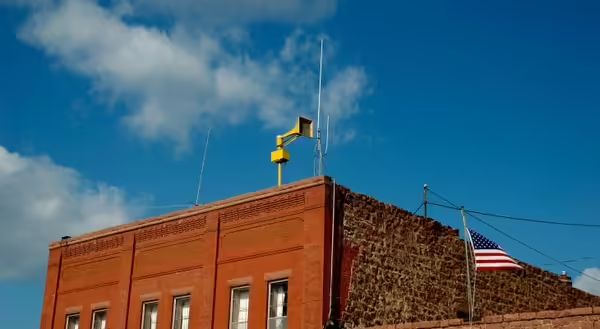
Ominous clouds and an approaching storm may be accompanied by the wail of a community siren. Other times they can be heard in the morning on what may be a nice day. What do the different blasts of the siren mean?
Sirens are part of the Public Alert System to let those outdoors be aware of a local or national emergency. Originally designed for civil defense, sirens are also commonly used in the Midwest and other locations to alert people of severe weather.
It’s important to realize that sirens are only meant to provide a warning to individuals that are outdoors. The sirens are not meant to be heard well indoors. Those indoors can be alerted by TV, radio, and weather app.
How are sirens used?
Basic types of sirens are directional, rotating, and omni-directional.
If you have lived in different communities, you may have experienced different practices for siren use. Given the unique circumstances of communities of every size across the nation — it is important to understand that there is no single method of alert and notification that meets the needs of every portion of every community in every situation. Having said that, here are some common procedures for sirens in Illinois.
Weather alert
For weather alerts, the sirens may sound if there are tornadoes or very severe weather such as large hail and extreme winds. This means the storms are close and may affect those who can hear the alert.
- Once heard, people should head to a safe location such as a sturdy building or a vehicle if a building is not nearby.
- It also means “turn on a radio or television and listen for essential emergency information."
The sound for a weather alert is a steady signal, if the siren is not rotating, for 3 to 5 minutes. Some locations may include voice alerts after the siren. Typically most communities do not sound an “all clear” alert, as people should still be indoors.
Civil defense alert
A civil defense alert will be more of a warbling up and down sound, much like the air raid sirens you hear on war movies or documentaries. In some cases it may be a series of short blasts.
System tests
Systems are tested on a monthly basis. In Illinois, sirens are tested on the first Tuesday of each month at 10 a.m. According to the Federal Emergency Management Agency, FEMA, outdoor warning sirens offer various tests.
Three of the most common tests are:
- A growl test, which assesses whether the siren will produce alert tones by sounding it at a low volume
- A health status test, which assesses the functionality of all system components such as speaker performance, wired connections between sirens and their control units, and wireless communication links.
- A silent test, which assesses some or all of the siren functionality evaluated with a health status test but virtually without sound.
How are sirens activated?
Weather alerts in most communities are activated by local authorities such as police and fire departments or local emergency management personnel. Most outdoor warning sirens require some sort of activation and control system to regulate its operation.
Simpler products can be operated with an electronic push-button control unit, which connects with wires or cables to the siren. More sophisticated products have digital control units so that the siren can also be operated from a computer using a wired Ethernet connection or with various wireless technologies including cellular, satellite, and radio. These options give agencies greater flexibility to operate and test their sirens from a remote or centralized location such as an emergency operations center.
Some outdoor warning sirens can also be activated through the Common Alerting Protocol (CAP), a standardized data messaging format. CAP messages can be generated by public safety officials with a variety of commercially available CAP software programs. For more information, visit the Illinois Emergency Management website or FEMA's website.
ABOUT THE BLOG: All About Weather is a blog by Duane Friend that explores the environment, climate, and weather topics for Illinois. Get in-depth information about things your weather app doesn't cover from summer droughts to shifting weather patterns. Never miss a new post! Sign up for our email list.
MEET THE AUTHOR: Duane Friend is an energy and environmental stewardship educator with University of Illinois Extension, serving the organization in many roles since 1993. Duane provides information and educational programs to adult and youth audiences in the areas of soil quality, weather and climate, energy conservation, and disaster preparedness. These programs provide practical solutions for families, farms, and communities. He assists families in creating a household emergency plan, farmers with the implementation of soil management and conservation practices, and local government officials and business owners with energy conservation techniques.
